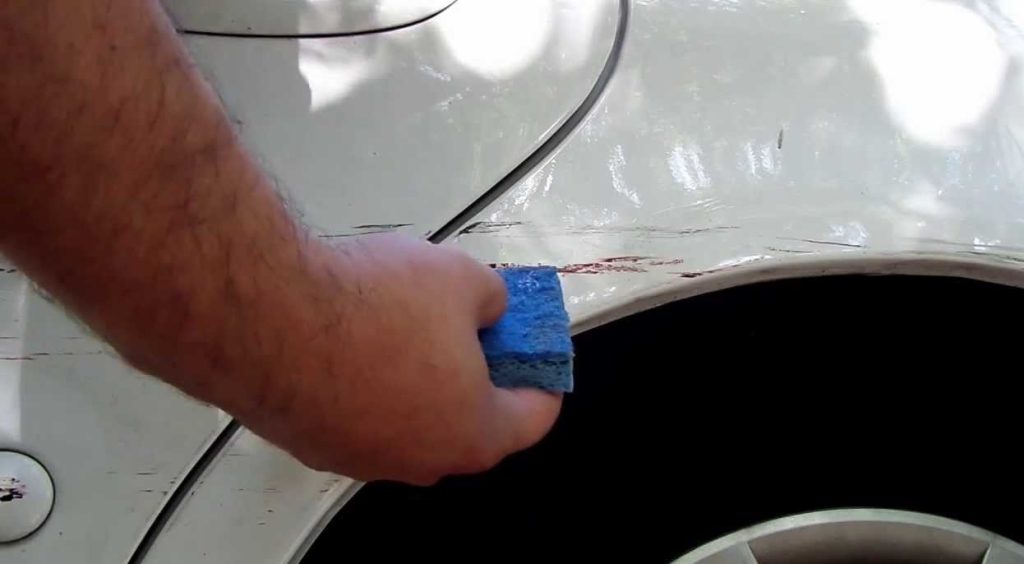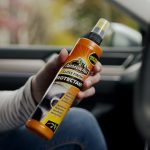Are you frustrated by the sight of unsightly oil paint stains marring your car’s otherwise sleek exterior? Fear not! This comprehensive guide is your go-to resource for banishing those stubborn blemishes and restoring your vehicle to its former glory. We’ll walk you through a step-by-step process, providing expert tips and tricks to make your car shine like new.
Table of Contents
- Understanding the Challenge
- Assessing the Damage
- Essential Tools and Materials
- Step-by-Step Removal Process
- Post-Removal Care
- Additional Insights
- Expert Tips for Effortless Oil Paint Removal
- Frequently Asked Questions (FAQs) About Removing Oil Paint From Car Body
- 1. How Does Oil Paint Adhere to Car Surfaces?
- 2. Can I Use Any Type of Cloth to Wipe Off Oil Paint?
- 3. Is Rubbing Alcohol Safe for Car Paint?
- 4. What Should I Do If the Oil Paint Stain is Extensive?
- 5. How Often Should I Wax My Car After Removing Oil Paint?
- 6. Can I Use Harsh Chemicals to Speed Up the Removal Process?
- 7. What Should I Do If the Paint Stain Persists After Initial Removal Attempts?
- 8. Is Clay Bar Safe for All Car Finishes?
- 9. Can I Remove Oil Paint Stains with Water-Based Paint Removers?
- 10. Is Removing Oil Paint a DIY Job or Should I Seek Professional Help?
- Conclusion
Understanding the Challenge
Before we delve into the solutions, it’s imperative to comprehend the intricacies of the problem. Oil paint, known for its tenacious adherence, presents a formidable challenge when it comes to removal. However, armed with the right knowledge and approach, you can confidently tackle this issue and transform your car’s appearance.
Assessing the Damage
- Identify the Paint Type: Not all paints are created equal. Begin by determining whether the paint is oil-based or water-based, as this crucial detail will inform your removal strategy.
- Extent of the Stain: Size matters. Assess the dimensions and depth of the oil paint stain. Is it a minor splatter or a more extensive mark? This information guides the selection of the most suitable removal method.
Essential Tools and Materials
Gather the following items before embarking on the paint removal process:
- Microfiber Cloth: Gentle yet effective, a microfiber cloth ensures thorough cleaning without risking scratches.
- Clay Bar: This invaluable tool aids in lifting contaminants off the car’s surface, preparing it for the removal process.
- Car Wash Soap: Opt for a mild soap to cleanse the affected area without causing damage.
- Rubbing Alcohol: An essential component for dissolving oil-based paint effectively.
- Soft Bristle Brush: Perfect for agitating and loosening paint particles without compromising the car’s finish.
Step-by-Step Removal Process
Preparing the Surface
- Wash the Car: Initiate the process with a comprehensive car wash, utilizing soap and a microfiber cloth to remove loose particles.
- Clay Bar Application: Employ the clay bar to lift contaminants off the surface, creating a pristine canvas for the subsequent removal steps.
Targeting the Stain
- Isolate the Area: Pinpoint the exact location of the oil paint stain, concentrating your efforts for a more focused approach.
- Rubbing Alcohol Application: Apply rubbing alcohol to a cloth and gently rub the paint stain. The alcohol’s properties are adept at dissolving oil-based paint.
- Soft Bristle Brush: For more persistent stains, introduce a soft bristle brush to agitate and loosen the paint particles, all while preserving the integrity of the car’s finish.
Post-Removal Care
- Rinse Thoroughly: Following successful paint removal, rinse the treated area thoroughly to eliminate any lingering residue.
- Inspect for Damage: Take a moment to scrutinize the treated area for potential damage. If the paint or clear coat appears compromised, it might be prudent to seek professional assistance.
Additional Insights
Preventive Measures
- Waxing the Car: Once the paint is successfully removed, consider applying a layer of wax to your car. This not only adds a protective coating but also acts as a deterrent against future paint adhesion.
Professional Help
- Complex Cases: In instances where the paint stain is exceptionally stubborn or widespread, seeking professional detailing services may be the best course of action.
Expert Tips for Effortless Oil Paint Removal
Dealing with oil paint stains on your car’s body can be a real challenge, but fear not! We’ve compiled a set of expert tips to make the removal process a breeze. Follow these guidelines for a spotless and rejuvenated vehicle.
1. Act Swiftly:
Time is of the essence when dealing with oil paint stains. The sooner you address the issue, the easier it is to remove. Fresh stains are less likely to have deeply bonded with the car’s surface, making them more susceptible to the removal process.
2. Know Your Paint:
Different paints require different approaches. Before you start, determine whether the paint on your car is oil-based or water-based. This knowledge is crucial for selecting the right removal method that effectively eliminates the stain without causing any unintended damage to your vehicle’s finish.
3. Test in an Unobtrusive Area:
Prior to applying any removal method, conduct a test in a small, inconspicuous area of your car. This precautionary measure ensures that the chosen method won’t adversely affect the paint or finish. It’s a smart way to avoid unintended consequences and maintain the overall aesthetic of your vehicle.
4. Use Quality Microfiber Cloths:
When it comes to wiping away the paint, invest in high-quality microfiber cloths. These soft and absorbent materials are effective at lifting particles without causing scratches. By using quality cloths, you’re taking an extra step to protect your car’s exterior during the cleaning process.
5. Gradual Rubbing Alcohol Application:
Rubbing alcohol is a potent ally in removing oil-based paint, but it’s essential to apply it gradually and gently. This approach allows the alcohol to dissolve the paint effectively without causing any harm to the car’s surface. Patience and a delicate touch are key to achieving optimal results. (See Also: How To Remove Nail Polish From Car Paint: Quick and Easy Solutions)
6. Consider a Clay Bar:
Incorporating a clay bar into your cleaning routine can elevate your paint removal efforts. This tool is excellent for lifting contaminants off the surface, creating a smoother canvas for the subsequent removal process. It’s a professional-grade solution that ensures thorough cleaning without compromising your car’s finish.
7. Avoid Harsh Chemicals:
Harsh and abrasive chemicals can do more harm than good. Stick to mild soaps and proven solutions for a safe removal process. The goal is to remove the paint without compromising the integrity of your car’s finish.
8. Soft Bristle Brushes for Stubborn Stains:
Persistent stains may require a bit more effort. Introduce a soft bristle brush into your cleaning arsenal, using it carefully to agitate and loosen paint particles without causing damage. This targeted approach is effective against stubborn spots.
9. Thorough Rinse:
After successfully removing the paint, give the treated area a thorough rinse. This step is crucial for eliminating any residue, leaving your car’s surface clean and free of any cleaning agents.
10. Regular Waxing:
Once the oil paint is successfully removed, consider making waxing a regular part of your car maintenance routine. This not only enhances the overall appearance of your vehicle but also provides an additional layer of protection against future paint adhesion. Regular waxing helps maintain the shine and safeguards your car’s exterior from potential contaminants.
By incorporating these expert tips into your oil paint removal process, you can navigate the task with confidence, ensuring your car maintains its aesthetic appeal for miles to come. With a thoughtful and meticulous approach, your vehicle will stand out on the road, free from the remnants of oil paint stains.
Frequently Asked Questions (FAQs) About Removing Oil Paint From Car Body
Dealing with oil paint stains on your car can be a common headache for many vehicle owners. In this section, we address some frequently asked questions to provide clarity on the best practices for removing oil paint and restoring your car’s pristine appearance. (See Also: How to Remove Duct Tape Residue off Car Paint: A Quick Guide)
1. How Does Oil Paint Adhere to Car Surfaces?
Oil paint adheres to car surfaces due to its composition and adhesive properties. The oily nature of the paint allows it to bond with the car’s clear coat, making removal challenging without the right techniques.
2. Can I Use Any Type of Cloth to Wipe Off Oil Paint?
It’s recommended to use high-quality microfiber cloths for wiping off oil paint. These cloths are gentle on the car’s surface and effective in lifting paint particles without causing scratches.
3. Is Rubbing Alcohol Safe for Car Paint?
Yes, rubbing alcohol is generally safe for car paint. However, it’s crucial to apply it gradually and gently to avoid any potential damage. Always conduct a test in an inconspicuous area before widespread application.
4. What Should I Do If the Oil Paint Stain is Extensive?
For extensive oil paint stains, consider seeking professional detailing services. They have the expertise and tools to tackle stubborn stains without compromising your car’s finish.
5. How Often Should I Wax My Car After Removing Oil Paint?
It’s advisable to wax your car regularly after removing oil paint. A good rule of thumb is to wax your car every 3-6 months to maintain its shine and provide an additional protective layer.
6. Can I Use Harsh Chemicals to Speed Up the Removal Process?
Avoid using harsh chemicals, as they can damage your car’s paint and clear coat. Stick to mild soaps and proven solutions to ensure a safe and effective removal process.
7. What Should I Do If the Paint Stain Persists After Initial Removal Attempts?
If the paint stain persists, try using a soft bristle brush to agitate and loosen the particles. However, exercise caution to prevent damage to the car’s finish. If the problem persists, consider professional assistance.
8. Is Clay Bar Safe for All Car Finishes?
Generally, a clay bar is safe for most car finishes. However, it’s essential to follow the manufacturer’s instructions and test it in a small area first to ensure compatibility with your specific car’s finish. (See Also: How Long Does Car Wax Take to Dry? Tips for Quick and Effective Drying)
9. Can I Remove Oil Paint Stains with Water-Based Paint Removers?
Water-based paint removers are designed for water-based paints and may not be as effective for oil-based paint stains. It’s crucial to identify the type of paint before choosing a removal method.
10. Is Removing Oil Paint a DIY Job or Should I Seek Professional Help?
Small to moderate oil paint stains can often be addressed through a DIY approach. However, for extensive or stubborn stains, seeking professional help is advisable to avoid unintentional damage to your car’s surface.
These FAQs provide valuable insights into the intricacies of removing oil paint from your car body. By following expert advice and guidelines, you can navigate the process successfully and enjoy a paint-free, revitalized vehicle.
Conclusion
In conclusion, armed with these expert tips on how to remove oil paint from your car body, you can confidently take matters into your own hands. Patience is key, and with a bit of diligence, your car will thank you with a glossy, paint-free exterior. Bid farewell to those persistent stains and say hello to a spotless, revitalized ride that turns heads wherever it goes!


